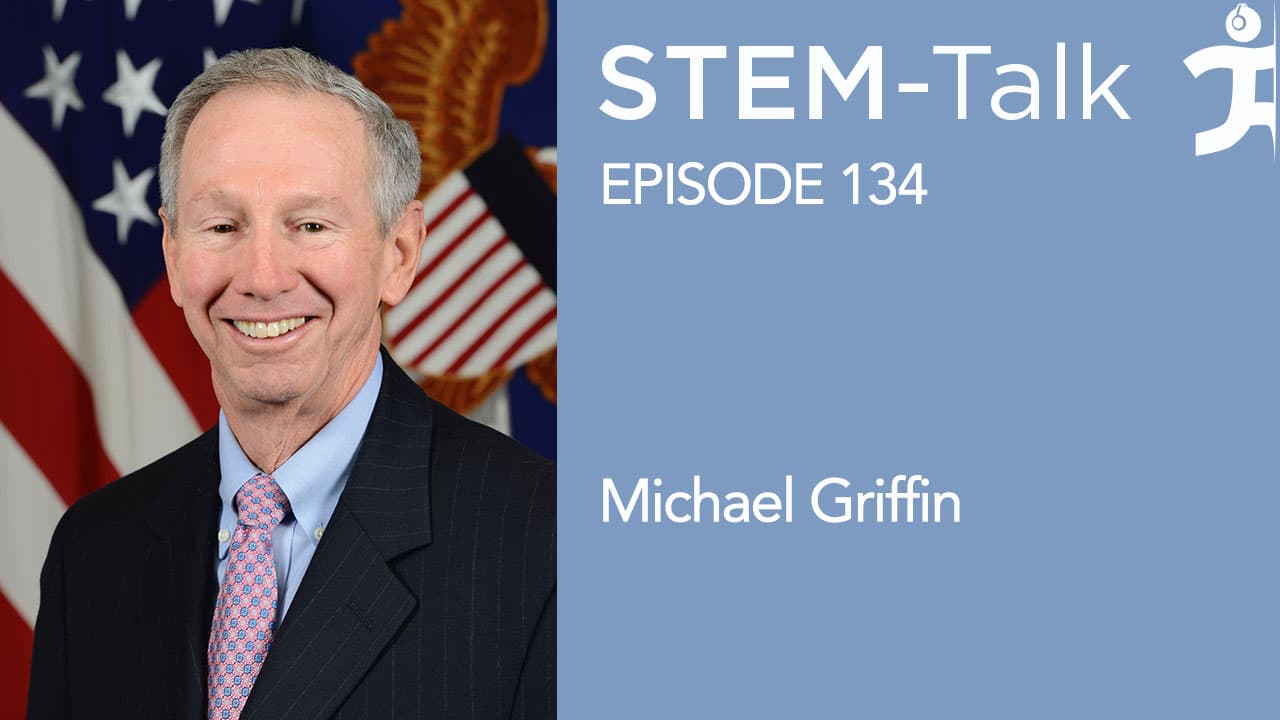STEM-Talk
Episode 134: Mike Griffin discusses America’s hypersonic arms race with Russia and China
// Mar 28, 2022

Our guest today is Dr. Michael Griffin, the Pentagon’s former Undersecretary of Defense for Research and Engineering. During his two and a half years as undersecretary, Mike made hypersonic weapons and defense against them his number one priority.
In today’s episode, Mike talks about the history of hypersonic technology; why he made it his number one priority at the Department of Defense; and why Russia’s and China’s growing hypersonic capability represents a serious threat to America’s national security.
Our interview with Mike was conducted on March 23, one month following Russia’s invasion of Ukraine. The weekend prior to our interview with Mike, Russia reported that it used a hypersonic missile to strike a Ukrainian military facility.
This is Mike’s second appearance on STEM-Talk. He was our guest on episode 23 back in 2016 when we talked to him about his tenure as NASA Administrator from April of 2005 to January of 2009.
Mike holds numerous academic degrees, including a BS in physics from Johns Hopkins, five master’s degrees, and a Ph.D. in aerospace engineering from the University of Maryland. In addition to serving as NASA Administrator and Undersecretary of Defense for Research and Engineering, his long career has included numerous other academic and corporate positions.
Show notes
[00:04:33] Dawn welcomes Mike back to the podcast, mentioning that when Mike was last on STEM-Talk in 2016, he talked about space exploration and his tenure as NASA administrator. Dawn goes on to mention that since then, Mike served a two-and-a-half-year stint as the Pentagon’s first research and engineering undersecretary, a position Congress created in 2018. Mike talks briefly about his perspectives on hypersonics research and development in the U.S. as well as in China and Russia. [00:05:36] Ken asks Mike to give a brief definition of hypersonics, given that during his time as undersecretary, he made hypersonics his top priority. [00:09:59] Ken mentions that last weekend, Russia reportedly used hypersonic weapons in Ukraine. Ken asks if Mike has any thoughts as to why the Russians are using hypersonic weapons in Ukraine as opposed to other less expensive weapons that would have sufficed from a military perspective. Ken wonders whether the use of hypersonics was primarily for strategic messaging. [00:12:26] Ken asks Mike about his op-ed in Breaking Defense that he recently co-authored and was titled, “Rethinking the hypersonic debate for relevancy in the Pacific.” [00:15:17] Ken points out that many U.S. leaders view China as primarily a trading partner and a source of inexpensive goods rather than a power that regards the U.S. as an adversary. [00:16:49] Mike describes hypersonics in more detail and explains the implications for national security. [00:18:28] Dawn mentions that hypersonic technologies are often thought of as relatively new. Mike talks about how the first hypersonic systems were actually used during World War II by the Germans. [00:19:34] Ken explains that the aerodynamic heating that occurs at hypersonic speeds is very intense. As a result, the propulsion technology, airframe materials and thermal management involved in hypersonics is very demanding. Ken goes on to say that in the mid-1950s, this was an issue the Air Force had to overcome during its development of the Atlas Intercontinental Ballistic Missile. Ken asks Mike to discuss aerodynamic heating caused by hypersonic speeds and how it was handled with respect to the Atlas missile. [00:23:12] Ken asks about the challenges NASA faced in overcoming aerodynamic heating on the Command Module for the Apollo missions during reentry, which would reach speeds up to Mach 35. [00:23:49] Dawn explains that hypersonic weapon systems fall primarily into two classifications: air-breathing cruise missiles and hypersonic boost-glide systems. She asks Mike to give an overview of these two systems and asks if as a country we should invest in both. [00:30:01] Ken asks Mike whether a powered cruise missile or a hypersonic boost-glide system is more challenging to develop and deploy. [00:32:44] Ken explains that the United States has actively pursued the development of hypersonic weapons as a part of its conventional global strike program since the early 2000s. Ken adds that partly thanks to Mike’s efforts, the Pentagon and Congress have recently shown a renewed interest in the development and deployment of hypersonic systems, possibly due to the existence of operational Russian and Chinese hypersonic systems. Ken asks Mike when he thinks the U.S. might have operational hypersonic capability and what it might be like. [00:35:00] Ken asks Mike about the balance between developing hypersonic weapons and developing a new type of defense system to counter the Russian and Chinese threat. [00:40:41] Ken follows up by asking if the space development agency is adequately funded and staffed for the task of developing a detection and defense system for hypersonic weapons. [00:42:59] Dawn asks why the United States fell behind in hypersonic technology when in the ‘60s the U.S. was the leader in this field, developing the X-15 aircraft that flew at hypersonic speeds. [00:45:12] Dawn mentions that the bedrock of military thinking since the start of the nuclear age has been the psychology of Mutually Assured Destruction, but that hypersonic missiles compress the time that a military will have to take defensive steps or retaliate. She asks if we are entering an era where the pressure to strike first is greater than ever. [00:49:02] Dawn asks if Mike thinks Washington, Moscow and Beijing might have serious discussions about the development and deployment of hypersonic technology that will eventually lead to treaties being negotiated by the superpowers. [00:53:05] Ken mentions that he recently listened to an interview with Dr. Mark Lewis, a former Air Force Chief Scientist, in which Mark and Dr. Dick Hallion remarked that the Russians and Chinese are indeed ahead of us in hypersonic technology. They pointed out China’s and Russia’s advantage is at least partly because they benefited substantially from the research, reports and papers that were produced by NASA and the Air Force. Ken asks if this view matches Mikes own observations. [00:55:30] Ken asks if there are any other nations, aside from Russia and China, with active hypersonics development programs. [00:56:56] Ken asks if Mike thinks our universities are producing the engineering brainpower we need to compete with the Chinese and Russians. [00:59:24] Dawn shifts to talk about NASA’s Perseverance Rover, which landed on Mars a year ago. She asks if Mike Agrees with NASA’s description of the landing as a pivotal moment for the United States and space exploration. [01:02:17] Ken mentions that Mike has long been an advocate for the human exploration of Mars. Ken also points out that Mike’s proposed strategy is to begin by returning to the Moon, which NASA is planning to do with the upcoming Artemis mission. NASA’s goal is to build a long-term human presence on the Moon. Ken asks Mike to discuss the strategy for the Artemis mission. [01:06:12] Dawn asks why Mike believes that returning to the moon and human exploration of Mars should be a national priority. [01:07:17] Dawn asks Mike for his thoughts about the likelihood of the U.S. working together with Russia again on space missions, given the conflict in Ukraine as well as the decision to suspend a joint European-Russian mission to Mars because of Ukraine. [01:09:30] Dawn closes the interview asking about Mike’s new company that he co-founded called LogiQ Inc, which provides high-end management, scientific and consulting services.Links:






